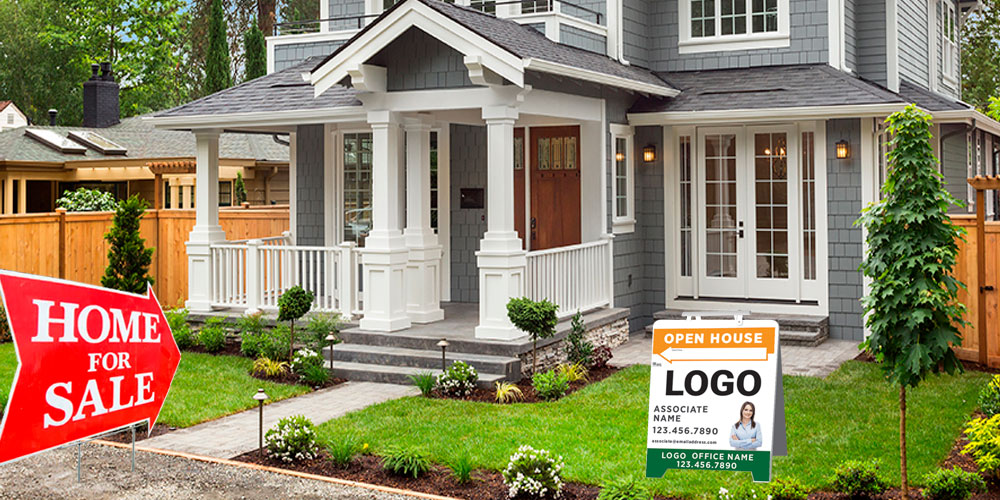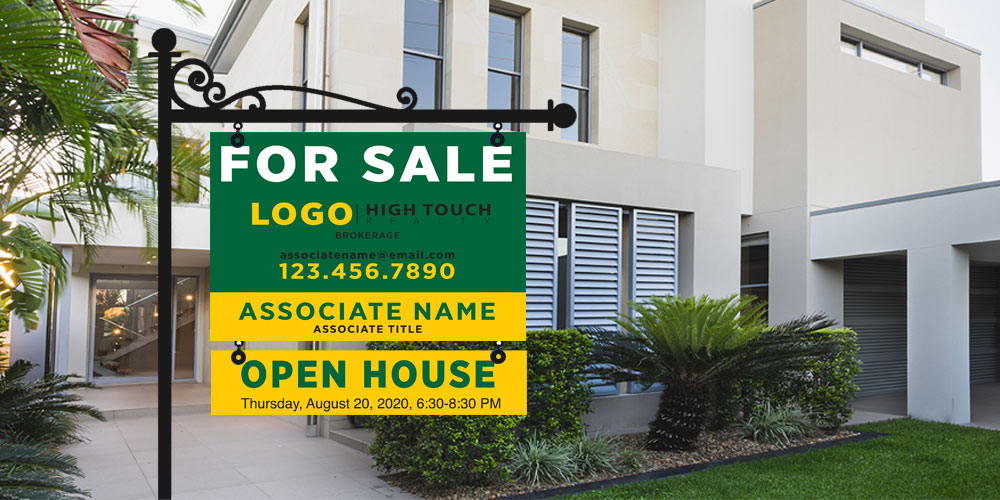A prospective buyer drives by a house, spots a real estate For Sale sign, slams on the brakes to take a look at the house, and calls the agent for more information. Now you have an excellent opportunity to discuss the unique features of the house that are not apparent from the curb. In this way, “for sale” signs can simply improve the marketing process. Signs for a property’s sale encourage inquiries about it. That is why they are still a widely used form of real estate advertising.
To help you speed up and increase sales as easily as possible, this blog post gives you the most crucial real estate For Sale sign guidelines. Here, we are going to explain the different types of For Sale signs, the most proper time and place, and other related rules and regulations.
Types of Real Estate For Sale Signs
Let’s start by discussing the various types of “For Sale” signs to familiarize ourselves with these helpful marketing materials. Common types of real estate signs vary in their construction, size, and intended use to advertise a property effectively, including:

Yard Signs
The most typical signage found on residential properties is yard signs. To attract onlookers, a sizable, robust panel is positioned on a lawn. They may have different shapes. A popular and timeless design, colonial post signs, for instance, are made up of a large hanging sign panel that is suspended from a decorative post-style frame. They are constructed for long-term use from weatherproof materials like aluminium or vinyl.
Another type of yard sign is a panel sign, which is typically made of aluminium or Coroplast and can be attached to pre-existing frames or posts. A-frame and sandwich board signs are portable, freestanding yard signs that are perfect for drawing people to a particular spot and drawing foot traffic.
Large-Scale Signs
Larger, more durable signage options are utilized for larger properties and developments. Large, 4×8-foot or larger hoarding and commercial signs are frequently placed alongside roads or highways to promote impending residential or commercial developments.
Banners and flags
Because of their versatility, vinyl banners can be personalized with a wide range of patterns and text. They are frequently employed for short-term promotions. On the other hand, tall and vertical feather flags are used to attract attention by waving in the wind. They are excellent for events and come in a variety of heights.
What Are “For Sale” Signs Made Of?
The two most popular materials for real estate signs are aluminium and Coroplast. Aluminium is a lightweight metal, and Coroplast is corrugated plastic. For your real estate signs, Coroplast is the least expensive choice. Installation of these metal-framed, custom-striped plastic panels is simple and long-lasting. Lamination is rarely necessary for this kind of symptom because they are already composed of sturdy Coroplast materials. However, aluminium For Sale signs are the perfect solution to withstand the extreme windy weather of Canada.
Real Estate For Sale Sign Guidelines for Design and Placement
No matter what kind of For Sale sign you choose, it will be useless if you include unnecessary details or design. As a real estate agent, you should know that real estate for sale signs must contain the name of the brokerage you work with and its address, the company’s logo, your office phone number, your website URL, and your email address. Avoid adding too many details to the design. The only information the viewer needs to follow up is your brand identity and contact details.

Size of Real Estate For Sale Signs
There are some basic real estate “for sale sign” dimensions that every agent should keep in mind when creating their listing signs. First, you need to decide on horizontal or vertical orientation. Then think about the amount of information you mention on the sign. Passersby won’t be able to see a lot of the information on the smaller panel. Placement may also affect the size of your real estate sign. A larger sign might be the best option if you want to put it farther down the street. The typical dimensions for horizontal real estate “For Sale” yard signs are 18″ x 24″ and 24″ x 36″, while vertical options include 24″ x 18″ or 36″ x 18″.
Read more: Common Sizes of Real Estate Signs in Canada: A Complete Guide for Agents
When to Set Up a For Sale Sign
The For Sale sign goes up when you have a ready-to-go purchase to alert potential buyers in the area. Of course, the property is never really sold until closing, but waiting until then will disappoint buyers (and sellers) more than ever. By serving as a neighbourhood announcement, the sign helps spark initial interest. Before the official listing date, some sellers put up a “Coming Soon” sign even earlier to generate leads and excitement.
Where to Put a “For Sale” Sign
Real estate “For Sale” signs are essentially used to attract the passersby’s attention to the house for sale. Make sure that your sign is not blocked by trees, parked cars, bushes, or light poles. If the house is located in a secluded area where the traffic is limited, you can get permission from the homeowners living in the busy areas to place a directional sign in their yards. If the property is located at the corner, it is recommended to set up a sign on each street. That way, you can attract potential buyers from both directions. When it comes to sign placement, remember to adhere to both local and provincial regulations.
Read more: Putting a For Sale Sign in Front of Your House: Pros and Cons
When to Remove a Real Estate For Sale Sign?
The most critical time to remove the sign is after the transaction has officially closed and all paperwork is complete. Although immediate removal after closing is preferred to avoid confusion for potential buyers, the recommended timeframe is typically within 24 to 72 hours of contract closing. You may think of the marketing benefits it has for you, but it can become a constant distracting element for the neighbours. Remember that many municipalities have rules about the removal of signs and that leaving them up for an extended period of time can result in fines.
Additions to Real Estate For Sale Signs

Metal signposts are essential additions to For Sale signs. Hanging a sign from a signpost has two advantages. First, it securely and confidently displays your message to the target audience. Second, it increases the visibility of your sign so that your sign can be easily spotted from a distance.
You can also take advantage of the space on top of or below the signpost to install custom rider signs. A rider sign may include the open house schedule, price reductions, a specific asking price, a QR code, and house features like amenities or the number of bedrooms.
Read more: Real Estate Sign Rules and Guidelines in Canada
Final Words
Though real estate For Sale signs are only one piece of marketing plans, they should never be overlooked or underrated. Successful signs for real estate for sale are self-evident. They increase the number of calls, open house visitors, and website traffic. Choose an engaging design for your signs and set them up at appropriate places to ensure maximum reach. Order your “for sale” sign from AgentPrint.com and be sure about the final quality of your print marketing materials.
In my opinion you are not right. I am assured. Let’s discuss it.
Completely I share your opinion. It is excellent idea. It is ready to support you.
Yes, all is logical
Is the selling agent recuired to change the “For Sale” sign with “Accepted offer” one after signing of a purchase agreement?-Thank you.
This question is related to real estate regulations and we recommend you ask the related authorities on this matter. Thank you for your interest in Agentprint.com.